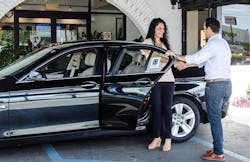Having a shuttle service is great, but as Jonathan Ortiz, general manager of his parents’ shop, Foreign Affairs Auto in West Palm Beach, Fla., says, there is always one person who gets the short end of the stick—and that’s the last person to get dropped off.
That person gets dragged along to all the other stops before finally getting dropped off at his or her destination. Or what about the customer that has to wait while your lone driver is scrambling to take other customers home?
That’s the dilemma Ortiz frequently encountered at his shop. Now at Foreign Affairs—thanks to some research on shuttle services and the utilization of Uber—the customer walks in, drops his or her car off, and gets a ride within minutes. It’s all given the shop a huge advantage in attracting and retaining customers.
The Backstory
Foreign Affairs Auto has had a shuttle service since 2004, as well as a designated driver. The driver’s responsibilities don’t just include driving guests, but also include other work such as parts running, providing valet parking and maintaining the building.
With a shop that does $2.4 million in revenue annually and has a monthly car count of 280, customers are coming in and out of the shop all day and need a way to get home. And with the ways technology is changing and ride-sharing apps are becoming more prevalent, Ortiz experimented with a way that would not only fulfill a ride service to the customer, but incorporate a modern way of doing so.
The Problem
Although Ortiz has an Audi A4 vehicle and a designated shuttle driver, the driver couldn’t fulfill all the ride requests he was getting in a timely manner. Performing his ancillary tasks and driving customers home proved difficult for one person.
And, since the shop preaches customer convenience, they needed a faster way to get customers home. Ortiz knew he didn’t want to allocate funds for a full-time driver or a loaner fleet because the long-term cost would be too high. Because Foreign Affairs works with high-end European cars, if he were to invest in a loaner fleet, he would have to get high-end vehicles, and with the overhead of gas, insurance and active registration, the cost doesn’t even compare.
Plus, having loaners is still somewhat of an inconvenience for customers because they have to go through the rental car process, and provide a driver’s license, insurance and a credit card.
Instead, management looked into a more budget-friendly option and found that Uber was an option that could potentially solve the problem of cost and timeliness for the shop and its customers.
The Solution
Initially, Ortiz began experimenting with Uber’s individual platform in the spring of 2016.
After seeing an advertisement for Uber Central on the news, Ortiz inquired about the service. He set up a company account that linked to the company card and the service writers on the team downloaded the app on their personal phones and linked to the account.
Over time, however, the personal platform (regular Uber) created confusion because the app would list the service writer’s information instead of the customer’s when ordering an Uber.
In recent months, however, Uber launched Uber Central, which allows companies to order multiple ride requests from a single account and utilize simple admin tools. Plus, having a smartphone is not required.
The service finally became available in his area in March 2017 and after following the given links, signing up was “instantaneous” and merged his company account onto the new platform.
The best part: There are no admin costs. All you're responsible for is paying for the individual rides, just like the individual platform, Ortiz says.
“Once the Uber Central came around, it had a lot of benefits and more control. It was great for us,” Ortiz says.
Now, instead of using personal smartphones to order customers an Uber, staff can log into the Uber Central portal on the shop’s computer, enter the customer’s information, pick-up and drop-off location and the customer receives a text message with details about the trip and driver, as well as a link to a live map.
Ortiz says that the shop doesn’t set a mile limit for how far they will take a guest.
“If the client is going to make the effort in driving 50 miles to come service with us,” he says, “we’re going to get them back home.”
The average Uber ride runs roughly $12 and during the shop’s busy season, Ortiz spends around $450 per month on the rides.
Although the shop has retained its shuttle car, Uber is still a cheaper alternative due to the car’s monthly insurance, active registration, gas and the driver’s salary, which all exceed the $450 per month the shop is spending now on Uber Central.
Ortiz also makes it a point to ask every client whether they’d prefer a personal driver or an Uber and emphasizes that the shop takes care of the cost and that, should the shuttle driver be out, it is a quicker alternative. Ortiz says that typically when the customer is informed that the Uber is the quickest way to get home, they are on board. The Uber accessibility adds another level of customer service that makes the shop memorable.
The Aftermath
Ortiz says that the majority of customers love that Uber is a service the shop utilizes and that it even makes the shop seem cool.
The only times he is met with skepticism tend to be with the older female customers who have perhaps read or heard horror stories about Uber drivers. They prefer the shop’s driver to take them home, which is fine for the shop, as it carries both options.
He also raises the point that although Uber isn’t a company of Foreign Affairs, it still acts as an extension of the shop and its reputation. If an Uber shows up and it does not meet expectations, whether that means the driver is not presentable or the car is not comfortable, the service advisor will cancel the order and request a new ride.
“We want this to be a seamless transaction for the customer,” Ortiz says. “In the end, it reflects their service experience with Foreign Affairs.”
The Takeaway
Thus far, Ortiz says there are no downsides to the service. It’s a cheaper and more convenient option for his customers and it’s ultimately one more thing to set him apart from his competition. For Ortiz, it’s important to offer as much value to the customer as the dollar they are giving you. He says he wouldn’t change anything as it has become an additional value-added service.
SHOP STATS: FOREIGN AFFAIRS AUTO Location: WEST PALM BEACH, FLA. Operator: Jonathan Ortiz Average Monthly Car Count: 280 Staff Size: 13 Shop Size: 10,000 sq ft; Annual Revenue: $2.4 million

